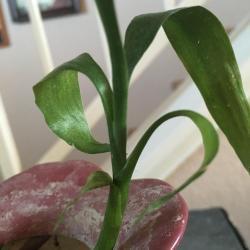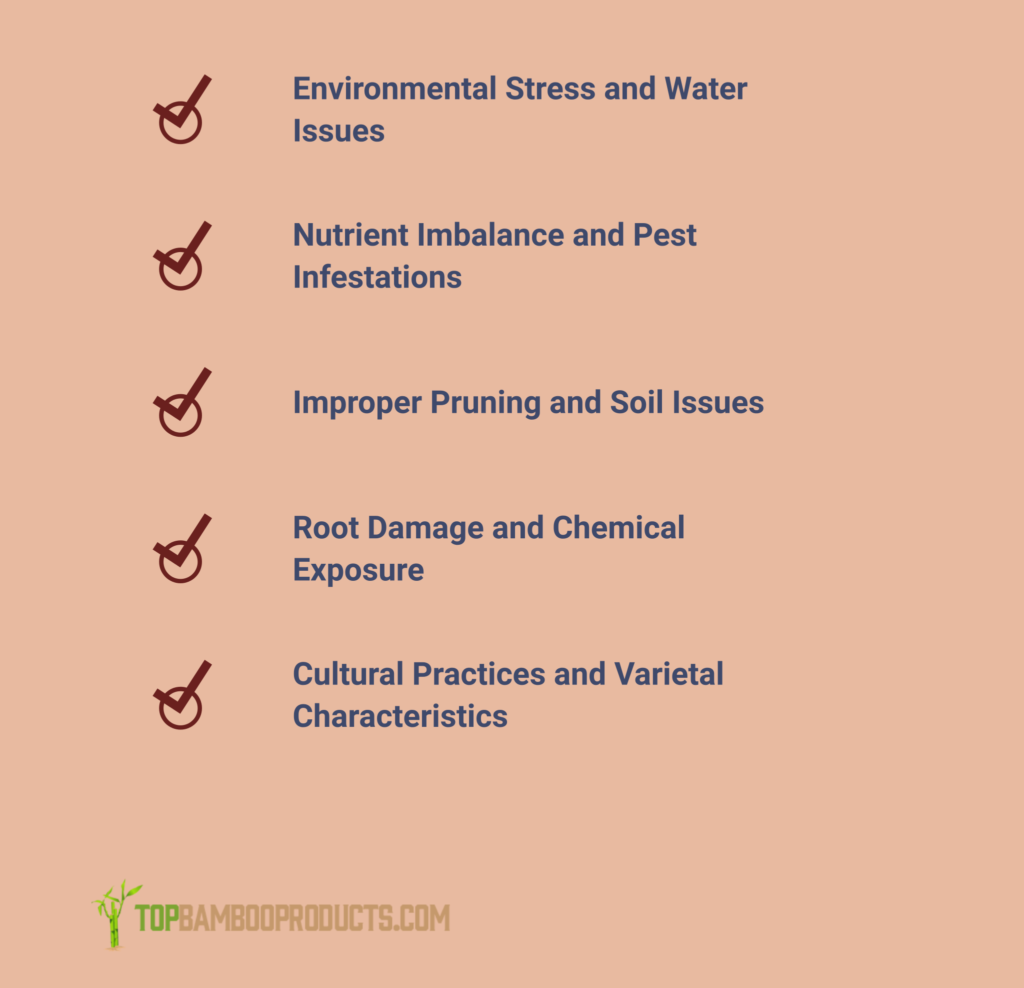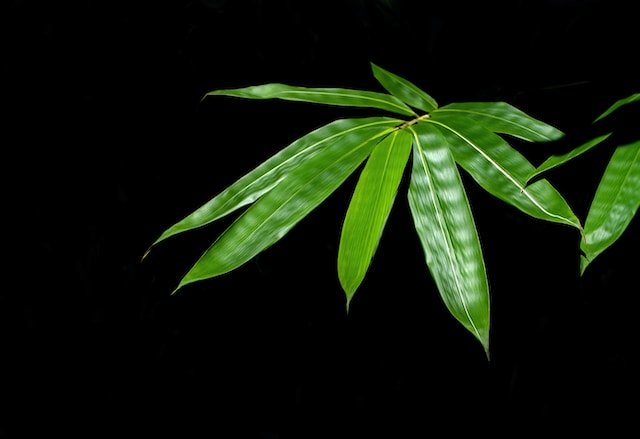Bamboo Plant Leaf Curl Management: Solution To Flawless Swaying Leaves
0Shares
Embracing the serenity of a garden comes with its share of challenges, one of which is ensuring the vibrant health of our green companions. Among the many wonders nature offers, the bamboo plant stands tall, a symbol of resilience and grace. Yet, even these resilient beauties can face their own set of woes, such as leaf curl. In this guide, we delve into the art of bamboo plant leaf curl management, unraveling the causes behind this phenomenon and uncovering the secrets to restoring your bamboo’s vitality.
Are you ready to save your bamboo plant? Gather your gardening tools, and let’s get started!
How Does Leaf Curling Affect the Overall Health of a Bamboo Plant?
 Photo by David Clode on Unsplash
Photo by David Clode on Unsplash
The way leaf curling affects the health of a bamboo plant really hinges on why it’s happening and how quickly we tackle the issue. If the cause is something temporary and we jump on it early, the plant can bounce back without much lasting harm. But if the problem sticks around or if the plant’s dealing with a bunch of stressors all at once, its health could take a hit. That might mean the plant doesn’t grow as well, loses some of its strength, and becomes more prone to other troubles down the line.
Does Bamboo Plant Leaf Curling Affect Other Leaves?
Absolutely, leaf curling in a bamboo plant can definitely have a domino effect on its other leaves. You see, when a leaf starts curling up, it’s like the plant’s way of waving a distress flag. It’s often trying to tell us that something’s not quite right in its world. It could be dealing with pests, diseases, not getting enough water, missing out on nutrients it craves, or even being bombarded by harsh weather conditions. But here’s the twist: that single curled leaf isn’t just an isolated case of drama. It’s a sneak peek into a larger issue brewing within the entire plant.
Picture this: One leaf curls up because it’s grappling with a pest invasion or some pesky disease. But guess what? These troublemakers are known to be travelers. They’ll hop from one leaf to another, turning the once-healthy leaves into their next hideout. And let’s not forget the water and nutrient story. If the poor plant isn’t getting the right amount of TLC in terms of water or nutrients, it’s like a chain reaction waiting to happen. Multiple leaves could end up getting cranky and curling, much like a protest in plant language.
Oh, and let’s not underestimate the power of the environment. Think of it as the plant’s neighborhood. If one leaf is throwing a tantrum due to excessive heat, strong winds, or blistering sunlight, it’s quite likely that its leafy buddies nearby will join the commotion.
Does Bamboo Plant Leaf Curling Means It Dying?
Absolutely not!
 Photo by National Gardening Association
Photo by National Gardening Association
Here’s the scoop: When you spot those bamboo leaves curling, it doesn’t automatically spell doom for your plant. See, there are a bunch of reasons why those leaves might be doing the twist, and not all of them are a death sentence for your bamboo buddy.
You see, a variety of different things can cause leaf curling. Sometimes, it’s like a stress signal from your plant, saying, “Hey, something’s up!” But it doesn’t always mean the end is near.
Think about it this way: Your bamboo might be feeling a little parched or drowning its roots with too much water. It’s like finding that perfect balance between Goldilocks’ porridge – not too dry, not too soggy – that can make those curls chill out.
And to know more about what causes leaf curling, keep reading the next section!
Different Factors Contributing to Bamboo Plant Leaf Curl
Bamboo, renowned for its graceful appearance and versatile uses, is not immune to the challenges that can plague plants. One such issue is leaf curl, a distressing condition where the edges or even the entirety of bamboo leaves become distorted, curling inwards. Understanding the multifaceted causes behind this phenomenon is crucial to maintaining the health and vibrancy of your bamboo plants.

1. Environmental Stress and Water Issues
Environmental stressors, a primary catalyst for leaf curl, encompass a spectrum of adverse conditions that bamboo plants might encounter. Among these, extreme temperatures—both excessively hot and freezing cold—can significantly disrupt a bamboo’s internal equilibrium, prompting leaves to curl in response. Changes in humidity levels can also provoke stress, as can incessant wind exposure. These stressors collectively disturb the delicate water regulation mechanisms of the plant, leading to leaf curl.
The delicate balance of watering can also be a decisive factor in preventing leaf curl. Overwatering, where the plant’s roots are persistently submerged, can lead to an array of problems including oxygen deprivation, root rot, and hindered nutrient uptake. Conversely, underwatering can cause the bamboo plant to experience dehydration and stress, a state that can manifest in the curling of its leaves. Striking the right balance in watering frequency and volume is a key step toward alleviating leaf curl.
2. Nutrient Imbalance and Pest Infestations
The intricate dance of nutrients within a bamboo plant can influence its overall vitality. Nutrient deficiencies, such as nitrogen, potassium, or magnesium, can provoke physiological imbalances that extend to the leaves. A deficiency in nitrogen, for instance, can lead to stunted growth and a distinctive yellowing of leaves, often accompanied by curling. On the other hand, excessive levels of certain nutrients can equally disrupt the plant’s equilibrium and lead to leaf curl.
The invisible world of pests and diseases presents another facet of the leaf curl conundrum. Pests such as aphids, mites, and caterpillars are known culprits in causing direct physical damage to leaves. Their feeding activity disrupts the integrity of the leaf surface, forcing the leaves to curl as a defensive mechanism. Additionally, diseases, especially fungal infections, can compromise the structural integrity of leaves, triggering curling as the plant attempts to quarantine the affected areas.
3. Improper Pruning and Soil Issues
Pruning, a necessary horticultural practice, can transform into a cause of stress-induced leaf curl when not executed with precision. Improper pruning techniques or excessive removal of foliage can disrupt the plant’s natural balance between photosynthesis and respiration, stressing the plant. In response, the bamboo leaves might curl as a sign of distress, diverting energy towards self-preservation.
The often-overlooked world beneath our feet also plays a pivotal role in leaf health. Poor soil drainage, where water accumulates around the roots, can suffocate them by displacing essential oxygen. Compacted soil further compounds the issue by limiting root expansion and water penetration. If the soil’s pH levels are skewed, nutrient availability can be compromised, leading to imbalances that contribute to leaf curl.
4. Root Damage and Chemical Exposure
Beneath the surface, the intricate web of roots holds the key to a bamboo plant’s well-being. Any damage inflicted on these vital structures—whether through transplantation or physical disturbances—can impede the plant’s capacity to absorb water and nutrients. This disruption reverberates upwards, causing leaves to curl as the plant grapples with compromised resources.
The modern gardening landscape introduces chemicals that can inadvertently induce stress in bamboo plants. Exposure to herbicides, pesticides, or other chemicals can disrupt the bamboo’s biochemical pathways, resulting in physiological stress. As a manifestation of this distress, the plant’s leaves might curl, a visible cry for relief.
5. Cultural Practices and Varietal Characteristics
Even the most well-intentioned cultural practices can inadvertently contribute to leaf curl. Planting bamboo too deep, failing to provide adequate spacing between plants, or employing incorrect planting techniques can lead to root stress. This root stress then extends to the leaves, compelling them to curl as the plant navigates these unfavorable conditions.
Each bamboo variety boasts a unique genetic makeup, which can render some types more susceptible to leaf curl than others. Certain varieties might inherently possess characteristics that predispose them to curl leaves under particular stressors. Recognizing these intrinsic vulnerabilities can aid in preemptive care.
Adhering to proper horticultural practices, addressing nutrient imbalances, and vigilantly managing pests and diseases are all paramount in ensuring the vibrant health of bamboo foliage. A holistic understanding of these contributing factors empowers plant enthusiasts to not only recognize the nuanced reasons behind leaf curl but also to implement effective strategies for its prevention and management.
Common Bamboo Plant Diseases that Manifest Leaf Curling
Leaf curling in bamboo plants can be attributed to a range of factors, including diseases. Several prevalent bamboo plant diseases can lead to noticeable symptoms of leaf curling.
Among these, the Bamboo Mosaic Virus stands out, as it induces leaf distortion and curling, typically disseminated through contaminated tools or insect vectors. Another disease, Bamboo Wilt, caused by the bacterium Xylella fastidiosa, obstructs the plant’s water-conducting vessels, resulting in wilting, yellowing, and leaf curling. Fungal infections like Powdery Mildew and Rust manifest as white powdery substances or rust-colored pustules on leaves’ surfaces, respectively, ultimately leading to leaf distortion.
Fusarium Wilt, characterized by fungal disruption of the vascular system, and Anthracnose, which causes lesions and leaf drop, can also provoke leaf curling. While Root Rot, caused by various fungi, can’t be directly attributed to leaf curling, it contributes by impeding water and nutrient uptake.
To ensure appropriate management, accurate identification of the underlying cause is imperative. Adequate cultural practices including proper watering, drainage, and sunlight are essential to minimize stress-related leaf curling. If a disease is suspected, consulting a local horticultural expert or plant pathologist for precise diagnosis and tailored treatment strategies is recommended.
Most Effective Bamboo Plant Leaf Curl Management
Managing bamboo plant leaf curl requires a multi-faceted approach that addresses both the underlying causes and the symptoms of the issue. Leaf curl in bamboo plants is often indicative of stress, inadequate growing conditions, or pest infestations. To effectively manage leaf curl, it’s essential to first identify and rectify the root causes.
Soil management
- Begin by evaluating the growing environment. Bamboo plants thrive in well-draining, slightly acidic soil with good moisture retention.
- Ensure that the soil is well-draining to prevent waterlogged conditions that can lead to stress and root rot.
- Regularly check the pH of the soil and amend it as necessary to maintain the appropriate acidity levels. Adequate moisture is crucial, but avoid overwatering, as it can lead to fungal growth and root problems.
Sunlight exposure
- Additionally, examine the plant’s exposure to sunlight. Bamboo plants prefer partial to full sun, depending on the species.
- Inadequate or excessive sunlight can stress the plant and contribute to leaf curl.
- Adjust the placement of the bamboo to provide it with the appropriate amount of light.
Pest management
- Pest management is another key aspect. Leaf curl can be triggered by insect infestations such as aphids, mites, or scale insects.
- Regularly inspect the bamboo leaves for any signs of pests, like discolored spots or webbing.
- If pests are detected, treat the plant with appropriate organic insecticidal solutions, ensuring you follow the recommended application guidelines.
Cultural practices and weather
- Avoid planting bamboo too close together, as overcrowding can lead to competition for resources and stress.
- Prune any damaged or diseased leaves, as they can contribute to the spread of problems.
- Applying a balanced, slow-release fertilizer during the growing season can also help maintain the plant’s health.
- Cold temperatures, wind, or sudden temperature fluctuations can stress bamboo plants and cause leaf curl.
- Protect the plants during extreme weather events and provide insulation as needed.
Can the Curled Leaves of Bamboo Plant Be Straight Again?

When you notice that the leaves of your bamboo plant have curled, it’s unlikely that they’ll straighten out by themselves. This curling can occur for several reasons, often linked to the factors mentioned above. This is likely due to environmental stress, problems with watering, the presence of pests or diseases, or even improper care practices.
If you find your bamboo plant’s leaves already curled due to stress or damage, the most effective approach is to tackle the root cause of the issue. By identifying and addressing what’s causing the stress, you not only prevent more damage from occurring but also create the conditions necessary for the plant to thrive in the long run. This can involve adjusting your watering routine, ensuring the plant is receiving the right amount of light, checking for pests or diseases and treating them if found, maintaining suitable humidity levels, and even considering light pruning if the leaves are severely affected.
Essentially, the goal is to create an environment in which your bamboo can recover and redirect its energy towards producing healthy, new growth. It’s important to remember that while bamboo plants are hardy, taking prompt and informed action can make a significant difference in nursing them back to their vibrant state.
What Season Do Bamboo Leaves Mostly Curl?
So, you’re curious about when bamboo leaves tend to curl, right? Well, it’s interesting because bamboo leaves primarily start curling during the dry season. You know, it’s all about water conservation for these plants. When the weather gets drier and there’s not as much water in the soil, bamboo, like many other plants, has this clever response to reduce water loss.
Imagine this: when the leaves curl up, they’re actually minimizing the surface area that’s exposed to the air. This helps them hold onto more water and not lose it through a process called transpiration. So, in a way, the leaves are like nature’s little water-saving experts!
Of course, the exact timing of when you’ll see these curled leaves can vary. It depends on the type of bamboo you’re looking at, the specific climate in your area, and how severe the dry season is. So, if you’re keeping an eye on bamboo in your region, it might be a good idea to chat with local gardeners or plant enthusiasts. They could give you more precise insights about when those bamboo leaves are likely to start curling up.
Final Words
Now you’re well-prepared with the necessary knowledge to effectively address the issue of leaf curl in your bamboo plants. Always keep in mind that a little care and attention can yield remarkable results. By closely observing your plant’s requirements and diligently following these straightforward steps, you’re on the verge of witnessing the revival of beautiful, unfurled leaves.
The gardening journey ahead involves a blend of patience, consistency, and affection for your bamboo companions. As you implement the strategies in our guide, consider each new leaf as a testament to your dedication. Through proper drainage, moisture control, and balanced nourishment, you hold the power to transform the health and appearance of your bamboo.
Gardening transcends being a mere hobby; it’s a nurturing relationship that harmonizes us with the natural world. So, as you rejuvenate your bamboo’s appearance, take a moment to relish the experience. Witness the gradual transformation, appreciate the intricate dance of growth, and revel in the rewards of your commitment.
With these insights at your disposal, you’re set to create a thriving haven of greenery. Your bamboo, now poised for recovery, will soon grace your surroundings with its timeless elegance. So, go ahead – embark on this fulfilling gardening adventure, and may the lush, vibrant leaves ahead bring you immense joy. Happy gardening!
To learn more about bamboo planting, just click here!
Frequently Asked Questions
Q1. What causes brown tips on bamboo leaves?
Brown tips are often due to underwatering, excessive fertilizer, or low humidity. Adjust watering and care routines accordingly.
Q2. What is causing white spots on my bamboo leaves?
Pests like mealybugs or powdery mildew could be the cause of white spots. Regular inspection and appropriate treatment can help.
Q3. Do bamboo leaves fall off in winter?
Bamboo is an evergreen plant, but some leaf drop might occur due to seasonal changes. It’s generally not a cause for concern.
Q4. How often do bamboo leaves need to be cleaned?
Cleaning leaves every few weeks helps remove dust and promotes better light absorption. Simply wipe them gently with a damp cloth.
Q5. Why do bamboo leaves have slits or cuts?
Slits or cuts in bamboo leaves are natural and aid in minimizing wind resistance, which helps the plant survive in windy environments.
0Shares
